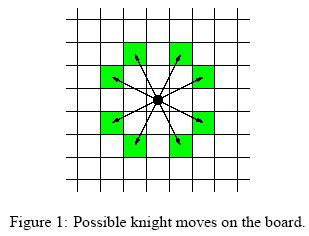Knight Moves
| Time Limit: 1000MS | Memory Limit: 30000K | |
| Total Submissions: 22220 | Accepted: 10384 |
Description
Background
Mr Somurolov, fabulous chess-gamer indeed, asserts that no one else but him can move knights from one position to another so fast. Can you beat him?
The Problem
Your task is to write a program to calculate the minimum number of moves needed for a knight to reach one point from another, so that you have the chance to be faster than Somurolov.
For people not familiar with chess, the possible knight moves are shown in Figure 1.

Mr Somurolov, fabulous chess-gamer indeed, asserts that no one else but him can move knights from one position to another so fast. Can you beat him?
The Problem
Your task is to write a program to calculate the minimum number of moves needed for a knight to reach one point from another, so that you have the chance to be faster than Somurolov.
For people not familiar with chess, the possible knight moves are shown in Figure 1.

Input
The input begins with the number n of scenarios on a single line by itself.
Next follow n scenarios. Each scenario consists of three lines containing integer numbers. The first line specifies the length l of a side of the chess board (4 <= l <= 300). The entire board has size l * l. The second and third line contain pair of integers {0, ..., l-1}*{0, ..., l-1} specifying the starting and ending position of the knight on the board. The integers are separated by a single blank. You can assume that the positions are valid positions on the chess board of that scenario.
Next follow n scenarios. Each scenario consists of three lines containing integer numbers. The first line specifies the length l of a side of the chess board (4 <= l <= 300). The entire board has size l * l. The second and third line contain pair of integers {0, ..., l-1}*{0, ..., l-1} specifying the starting and ending position of the knight on the board. The integers are separated by a single blank. You can assume that the positions are valid positions on the chess board of that scenario.
Output
For each scenario of the input you have to calculate the minimal amount of knight moves which are necessary to move from the starting point to the ending point. If starting point and ending point are equal,distance is zero. The distance must be written on a single line.
Sample Input
3
8
0 0
7 0
100
0 0
30 50
10
1 1
1 1Sample Output
5
28
0Source
TUD Programming Contest 2001, Darmstadt, Germany
bfs用sdl的list写,效率堪忧。换成queue。
麻烦的是queue没有clear,只能一个一个pop,或者新开一个queue。
#include <cstdio>
#include <cstdlib>
#include <queue>
#include <cstring>
using namespace std;
#define MAXN 303
int size = 0;
bool visit[MAXN][MAXN] = {0};
int mx[8] = {-2, -1, 1, 2, 2, 1, -1, -2};
int my[8] = {1, 2, 2, 1, -1, -2, -2, -1};
int step_num = 0;
struct point
{
int x;
int y;
int n;
};
queue <point> myq;
point sp;
point dp;
void init()
{
memset (visit, 0, sizeof(visit));
while(!myq.empty())
{
myq.pop();
}
return;
}
bool bfs(point p)
{
int x = p.x;
int y = p.y;
int n = p.n;
if (x < 0 || x >= size || y < 0 || y >= size)
return false;
if (visit[x][y])
return false;
visit[x][y] = true;
if (x == dp.x && y == dp.y){
step_num = n;
return true;
}
for (int i = 0; i < 8; ++i)
{
point newp;
newp.x = x + mx[i];
newp.y = y + my[i];
newp.n = n + 1;
myq.push(newp);
//printf("%d %d %d\n", newp.x, newp.y, newp.n);
}
return false;
}
int main()
{
int n = 0;
scanf("%d", &n);
for (int i = 0; i < n; ++i)
{
scanf("%d", &size);
scanf("%d%d%d%d", &sp.x, &sp.y, &dp.x, &dp.y);
init();
myq.push(sp);
while(!myq.empty())
{
if(bfs(myq.front()))
break;
myq.pop();
}
printf("%d\n", step_num);
}
}




 本文介绍了一个经典的骑士走法问题,并提供了一种使用广度优先搜索(BFS)算法求解的方法。该算法能够找出国际象棋中骑士从一个位置移动到另一个位置所需的最少步数。
本文介绍了一个经典的骑士走法问题,并提供了一种使用广度优先搜索(BFS)算法求解的方法。该算法能够找出国际象棋中骑士从一个位置移动到另一个位置所需的最少步数。

















 598
598

 被折叠的 条评论
为什么被折叠?
被折叠的 条评论
为什么被折叠?








